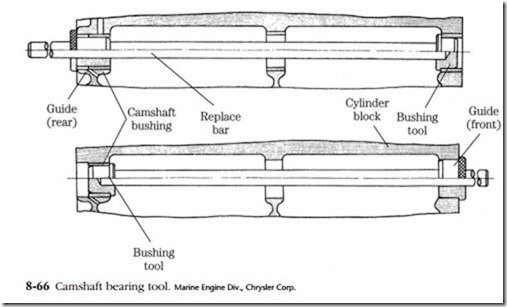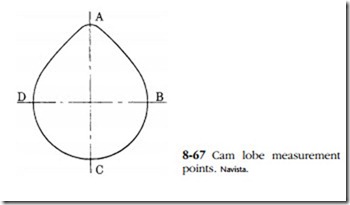Camshafts and related parts
Inspect the accessory drive gear train for tooth damage and lash. Crank and camshaft gears are pressed on their shafts and further secured by pins, keys, or bolts.
OHV cam and balance shafts are supported on bushings, which require a special tool, shown in Fig. 8-66, to extract and install. Normally, the machinist services in-block bushings, removing the old bushings and installing replacements that, depending upon engine type, might require finishing. The OEM practice of leaving bushing bores unfinished and reaming installed bushings to size complicates the rebuilding process. It is also possible for bushings to spin in their bosses, a condition that can be corrected by sleeving.
Camshaft lobes are the most heavily loaded parts of the engine, with unit pres- sures in excess of 50,000 psi at idle. Valve lifters, whether hydraulic or mechanical, are normally offset relatively to the lobes, so that contact occurs over about half of the cam surface. This offset, together with a barely visible convexity ground on the lifter foot tends to turn the lifter as it reciprocates. As the parts wear, the contact area increases and eventually spreads over the whole width of the lobe. Thus, if you find a camshaft with one or more “widetrack” lobes, scrap the cam, together with the complete lifter set. Although the condition is rare in diesel engines, overspeeding and consequent valve float might batter the flat toes of the lobes into points. Figure 8-67,
which illustrates lobe wear measurements, inadvertently illustrates this condition. The same two-point measurements should be made on the journals.
Normally, hydraulic valve lifters are replaced during a rebuild; attempting to clean used lifters is a monumental waste of time. This means that the camshaft must also be replaced, because new lifters will not live with a used camshaft (and vice versa). Assemble with the special cam lubricant provided, smearing the grease over each lobe and lifter foot. Oil can be used on the journals.
Replacement hydraulic lifters normally are charged with oil as received, and ample time must be allowed for bleed when screwing down the rocker arms on OHV engines. Some valves will be open; if the rockers are tightened too quickly, pushrods will bend. As mentioned earlier, the low bleed-down rates of Oldsmobile 350 lifters make rocker assembly an exercise in patience; most other rockers can be assembled in a few minutes of careful wrenching.
Break in the camshaft exactly per maker’s instructions. Otherwise, it will score.

